
The Leo Constellation – Facts in brief:
What is it The Leo Constellation?
The Leo Constellation is one of the 12 constellations of the zodiac and one of the largest constellations in the sky.
It is one of the easiest constellations to recognize, as it clearly resembles the outline of the lion, if you join the dots.
‘Leo’ means Lion in Latin.
Where is it The Leo Constellation Located?
It is positioned in the second quadrant of the Northern Hemisphere, or alternatively said to be located in the Northern Sky, or Northern Celestial Hemisphere (and sometimes it’s referred to being located in the NQ2 Quadrant).
It can be seen at latitudes between +90 degrees and – 65 degrees, an are which stretches from the North Pole down to the bottom of Argentina.
Leo is positioned between two other Constellations, Cancer (the Crab) to the west, and Virgo (the maiden) to the east. Constellations like Leo are located by co-ordinates like a right ascension or left ascension and their declination.
The Constellation Leo is found at around 10 hours, 30 minutes right ascension and a +15 degree north declination.
How can you spot Leo in the night sky?
The simplest method for finding any particular Constellation is to first of all locate the brightest star in that Constellation, and then look at the neighboring illuminations.
Therefore, the easiest way to spot the Constellation of Leo would be to locate the bright Star Regulus (Alpha Leonis) and try to imagine the surrounding shape of the lion by joining the illuminated dots (the other Stars). This simple technique can be used to spot other Constellation patterns like the Question Mark or the Bear.
The Constellation Leo is located very close to ´The Big Dipper´.
So, if you find the well-known Big Dipper asterism, then look for the 2 stars that represent the dipper part of that image (it´s opposite the handle of the Dipper) and draw an imaginary line from the dipper to the brightest Star, to the right, and you will be able to form the Lion shape of Leo.
The best months to spot the Constellation of Leo, the Lion and its trademark sickle are in April and May. It can be best seen in the Eastern sky in the Northern Hemisphere, and if viewed in the United States the best time of day to spot it is around 20.00 (EDT). This differs in other parts of the world.
Leo continues to be visible until July but as time approaches the period when the Sun houses Leo, late July, August it begins to fade. It will not return to visibility from behind the Sun until late September or October time.
How is it formed and named?
The Constellation of Leo is the 12th largest constellation in the Northern Celestial Sky, as it fills an area of 947 square degrees.
It has a simple and easy to identify a shape like ‘Leo the Lion” which is formed by the positions of the 9 main stars that make up the Constellation of Leo.
The 9 main Stars in Constellation Leo
There are many different Stars within the Constellation Leo.
The nine main stars of Leo, range in luminosity from the brightest (the Regulus Star, also known as Alpha Leonis) to the faintest (the Rasalas Star) in descending order of luminosity as follows:
- Regulus* (the brightest Star in Leo, and 21st brightest Star in the whole of the night sky)
- Denebola (the second brightest Star in Leo)
- Algieba
- Zosma
- Algenubi
- Chertan
- Adhafera
- Al Jabhah
- Rasalas (the faintest of the Bright Stars)
The brightest Star Regulus (Alpha Leonis) was known in most ancient civilizations as the prime Star of Leo.
*Regulus is the Latin name that is used without translation in many different languages around the world; but when the name is translated the meaning is more or less the same:
- The ‘Little King’ or ‘Prince’ in Latin.
- ‘Basiliscos’ in Greek, meaning the ‘little king, ‘little chief ‘ or ‘young ruler’
- ‘Qalb al Asad’ in Arabic meaning ‘the heart of the lion’
The importance of the Regulus star in Leo was described by the Babylonians as the ‘King’ Star, or positioned overall as the Star located at the breast of the Lion.
Who, or what represents Leo?
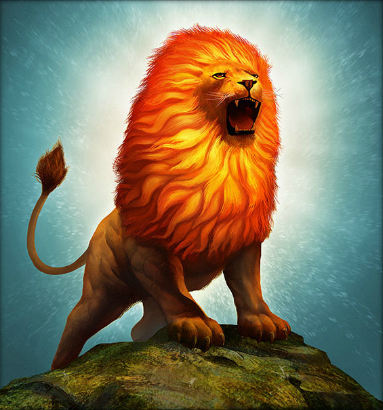
The Constellation Leo, is represented by – the Lion- which is associated with the ´Nemean Lion´, in Greek mythology or simply ‘Leo’.
The reason is that it looks very similar to the outline of a Lion and it´s easily recognized in the night sky.
It therefore was named by many ancient civilizations as a version of the word meaning the Lion or the King of the animals, and its main Stars in Leo have been named after parts of a Lion’s body.
How do the Bright Stars of Leo form the shape of a Lion?
The Bright Stars
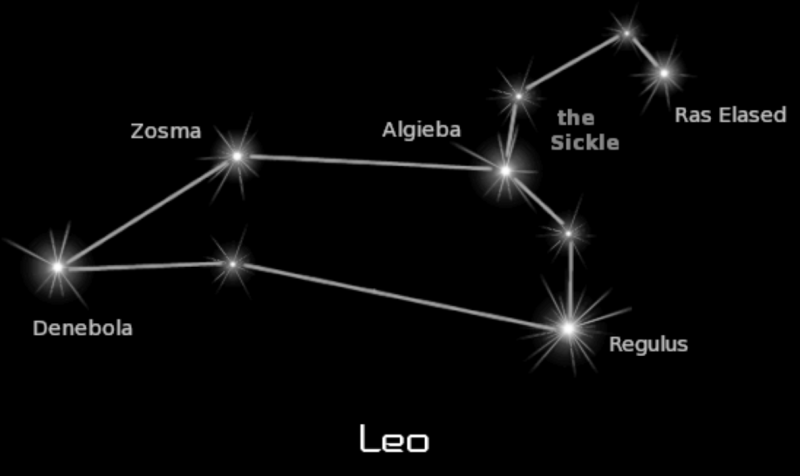
If you look up and into the night sky at the Constellation of Leo you can imagine the outline of Leo the Lion and the different parts of the lion´s body.
- The Head of the Lion – The ‘Sickle’ of Leo is made up of six bright Stars that represent the shape of the lion’s head.
- The heart of the Lion – represented by Regulus (Alpha Leonis), is located about 80 light years from earth.
- The tip of the tail of the Lion, or the Lion’s tail – represented by Denebola (Beta Leonis), is located about 35.9 years from earth.
- The neck of the Lion – represented by Algieba (Gamma Leonis) however the name Algieba actually means forehead!
- The rump of the Lion – is represented by Zosma (Delta Leonis)
- The mane of the Lion – is represented by Al Jabhah (Eta Leonis)
(A sickle is a hook-shaped implement and this shape is used to describe the pattern of the Stars that forms the head of Leo’s outline)
The Sickle of Leo includes the following Bright Stars –
- Regulus (Alpha Leonis)
- Algieba (Gamma Leonis)
- Adhafera (Zeta Leonis)
- Al Jabhah (Eta Leonis)
- Ras Elased Borealis or Rasalas (Mu Leonis)
- Ras Elased Australis or Algenubi (Epsilon Leonis)
Stars with Planets
Leo also has 13 Stars with Planets orbiting around them in the solar system but they are unlikely to be able to support life forms.
Stars without Planets
Leo has a further 92 cataloged Stars with no planets.
The Constellation Leo a total of 156 Stars.
Not all the stars within the Leo Constellation are visible to the naked eye but with telescopes and modern imagery techniques is it possible to glimpse all of the 156 stars.
When was it first discovered?
The Greeks were the first ancient culture to name the 88 Constellations in the sky.
They were each given 3-letter abbreviations to help identify them and the Stars within those Constellations are also referred to by those 3-letter codes.
Ptolemy
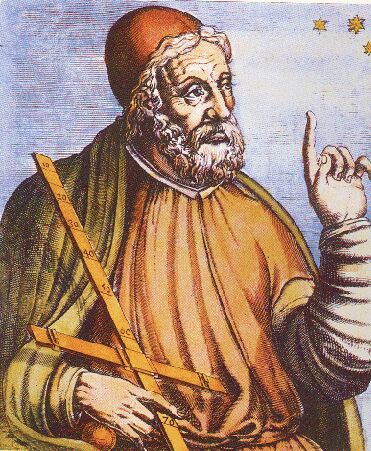
It was the Greek Astronomer – Ptolemy, who first cataloged the Constellation of Leo, in the 2nd Century (2 AD.). Ptolemy listed the various constellations in his Almagest (a book recording astronomical data).
When referring to a Star within a Constellation it is given the genitive form of the Constellation name. (‘Leo’ with ‘nis’, to give ‘Leonis’)
For example, within the Leo Constellation the Stars would be referred to by a name or a letter from the Greek Alphabet (in order of brightness) followed by ‘Leonis’, such as:
- Alpha Leonis (Regulus)
- Beta Leonis (Denebola)
- Gamma Leonis (Algieba)
- Delta Leonis (Zosma)
- Epsilon Leonis (Ras Elased Australis)
- Eta Leonis (Al Jabhah or Al Jabbah)
- Theta Leonis (Chertan)
The Constellations change their positions throughout the year as the Earth rotates around the Sun.
This means our position in space is forever changing and as a result our view of what’s in space changes too, and will continue to do so.
Why and what is the purpose of Leo?
In ancient times the dots, bright lights and perceived objects in the sky were of great interest and the makings of folklore to a great range of people from seamen to farmers.
From children to the elderly, we have had an ongoing fascination, with our solar system and star system. Perhaps it’s because the enormity and variety within it makes us realize just how large and exciting the universe is.
FACT: The Star System or Stellar System is a small number of stars that orbit around each other and are bound together by gravity. When it becomes a large group of stars, again bound together in the same way, by gravity, it is known as a Galaxy or Star Cluster. Whether they contain small groups of stars or larger groups of start the both come under the classification of ‘Star System’.
The Constellations in the night sky were a useful navigation tool and guide as well as the subject of legends and myths, about heroes like Hercules, and powerful gods.
42 of the Constellations have been named after animals with a story behind the name.
Leo Constellation: Background & Facts
Part of the Zodiac
The Constellation of Leo, found in the Northern Sky, is one of the constellations of the zodiac.
- When the zodiac ‘ring’ or ‘belt’, of constellations is listed in order, as the 12 astrological zodiac signs (months) of the calendar from January to December, it lists as:
Capricorn; Aquarius; Pisces; Aries; Taurus; Gemini; Cancer; Leo; Virgo; Libra; Scorpio and Sagittarius
- In the order of the vernal equinox (where the ecliptic meets the celestial equator) the order of the signs begins with Aries, the first, and then and runs through to Pisces.
However you categorize the list of the Constellations of the Zodiac, each Constellation in the belt, like Leo, has two immediate Constellation neighbors – one in front (e.g. Cancer is in front of Leo) and one behind it (e.g. Virgo is behind Leo).
Hiding in the house
The constellations in the Zodiac ‘belt’ forms an imaginary ring that’s closely aligned to the orbit of Earth.
As a result each of the 12 zodiac constellations has a cycle that passes through the Sun (the biggest and brightest Star, that is actually a Dwarf Star not a Giant Star).
The Sun is then said to house (hide) each Constellation in turn.
The Sun houses a different Constellation each month and then you cannot see that particular Constellation.
The Leo constellation season for being hidden behind the Sun is between July 23, and August 22. At this point Leo would be referred to as hiding in the house of Leo.
The neighbors of the Leo Constellation
The Constellation of Leo is neighbored by several constellations in the Northern Sky:
- Ursa Major (the Great Bear); Leo Minor (little Bear or Lesser Bear); Sextans, Virgo; Crater; Hydra, Cancer, Lynx and Coma Berenices.
Within Constellation Leo
The Constellation of Leo is formed by of a number of different components.
The different components housed by the Constellation Leo are mainly Stars, Deep sky objects and Messier objects (galaxies).
Stars
There are many different types of Stars in the star system categorized by size, lifespan and luminosity. Generally, larger Stars have a shorter lifespan.
Stars are formed from clouds of interstellar gas and include:
Red Dwarf Stars
Most of the stars in the galaxy are Red Dwarf Stars. They are small in size measuring about 40-50% of the mass of The Sun. They are cool and their luminosity has only about 10% of the brightness of the Sun (our brightest Star), and they live for longer.
Brown Dwarf Stars
These are known as failed stars that form like other stars but don’t reach the mass, heat or density to begin the nuclear fusion process. They are only about 8% of the mass of the Sun and are red not brown, and not easy to spot in the night sky.
Red Giant Stars
These are giant luminous stars that have a low or medium mass. A Red Giant Star is formed when a star expands its volume by fusing all of its hydrogen into helium, and then burning the helium to produce carbon and oxygen to expand.
Blue Giants
These are giant, bright stars that range from 10-100 times the size of the Sun and are 1000 times brighter. They are big and hot and therefore burn out quickly. The biggest are called Blue super giants or hyper giants. The biggest ever discovered was about 10 million times brighter than the Sun,
Yellow Dwarfs
These are main-sequence stars like the Sun, but only 80% of its size, and are bright stars,
White Dwarfs
These are small burnt out husks of stars, about the same size as the Earth. White Dwarfs are dense and represent the final state of evolution for a star, like most stars in the galaxy.
Black Dwarfs
These are the remains of a White Dwarf after it cools and darkens. This is likely to happen after about 10 billion years of life.
White Stars
These are also main-sequence stars like the Sun, but twice the size, and are bright stars and hot.
Other types of stars include the Orange Giant, Neutron stars, Variable Stars and Binary Stars
What is a Nebula?
A Nebula is a massive cloud of gas and dust in Space.
Some Nebulae are formed when a star explodes and then dies, as is the case with a Supernova. Sometimes they can act as Star nurseries and are the areas where new Stars are forming.
The Nebulae are the spaces in between the stars referred to as interstellar space.
Images of Nebulae have been captured by professional Space telescopes, like the Nasa Spitzer Space Telescope, operated by NASA , and the famous Hubble Space Telescope.
Bright Stars
The sky has various bright stars.
The brightness of a star is measured by a value called its magnitude and they come in different sizes, composition, mass and color.
The lower the magnitude value the brighter the star appears in the night sky when viewed from Earth.
The Leo Constellation houses two of the brightest Stars called Regulus (Alpha Leonis, which is the star that lies closest to the ecliptic) and Denebola, along with another star known as Wolf 359.
FACT: The Sun is considered to be the brightest star in the sky.
There are 13 named stars within the Constellation Leo that have been officially approved by the International Astronomical Union (IAU):
- Zosma; Subra;
- Sagarmatha;
- Regulus;
- Radalas;
- Moriah;
- Formosa;
- Dingolay;
- Denebola;
- Chertan;
- Alterf;
- Algieba
- Adhafera.
As well as Stars, the Leo Constellation also has various well-known deep sky objects and galaxies.
Deep Sky Objects
FACT: A Deep Sky Object is an astronomical object, that is not a solar systemobject like the Sun, Moon, Comet or a Planet, nor is it an individual Star.
Deep Sky Objects are faint objects that can still be observed by naked eye in the night sky from Earth. They include Galaxies, Star Clusters and Nebulae.
Galaxies
The galaxies covered by the Leo Constellation include:
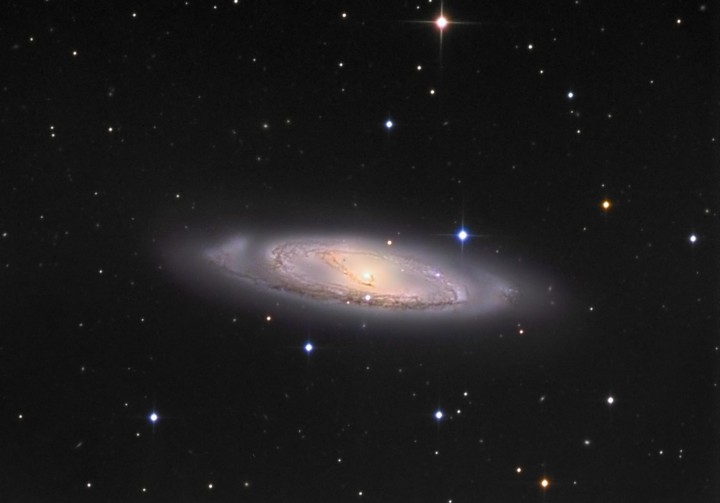
- Messier 65 – an intermediate spiral galaxy, that is 35 million light years away from Earth. Charles Messier is credited with discovering the Messier 65 galaxy, and Messier 66 in 1780
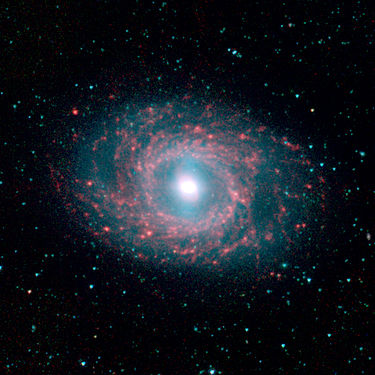
- Messier 95 (a barred spiral galaxy) and was discovered by Pierre Mechain, a French Astronomer, in 1781. It was then cataloged by Charles Messier within days.
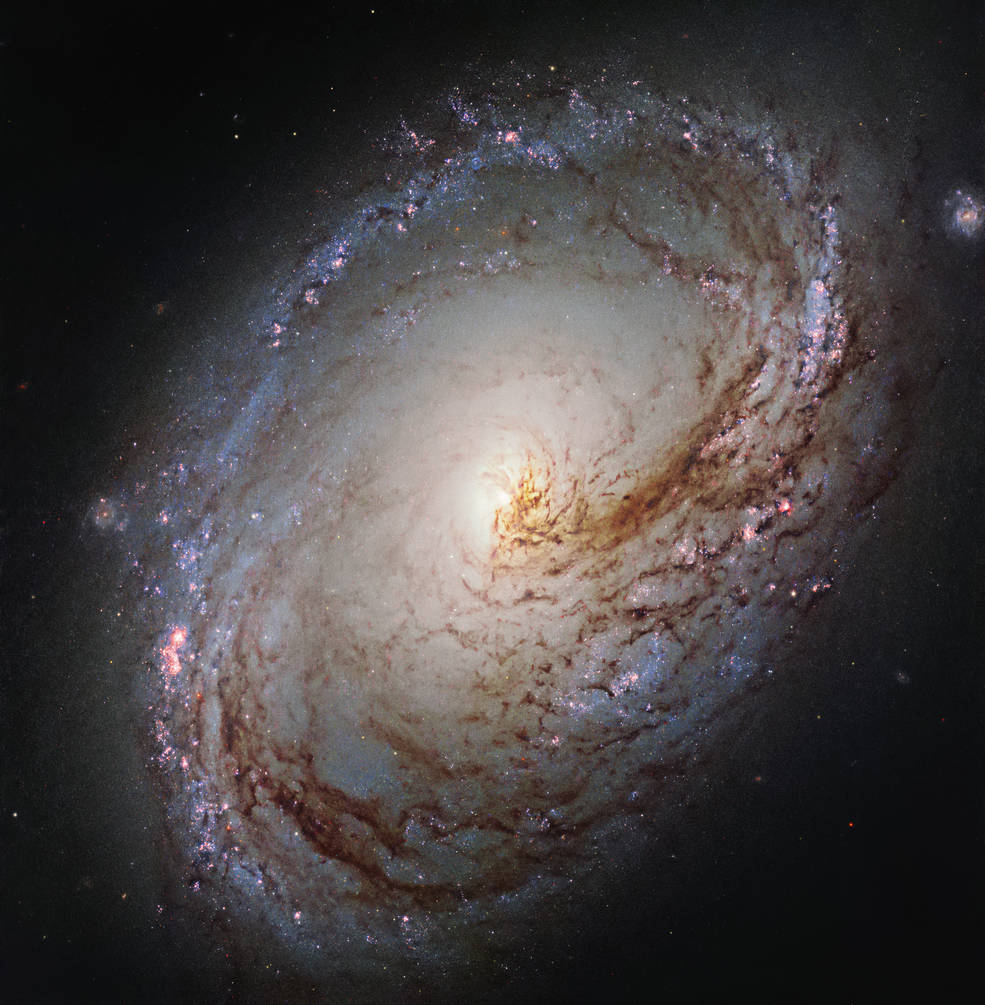
- Messier 96 (an intermediate spiral galaxy) also discovered by Pierre Mechain, a French Astronomer, in 1781 and cataloged by Charles Messier within days.
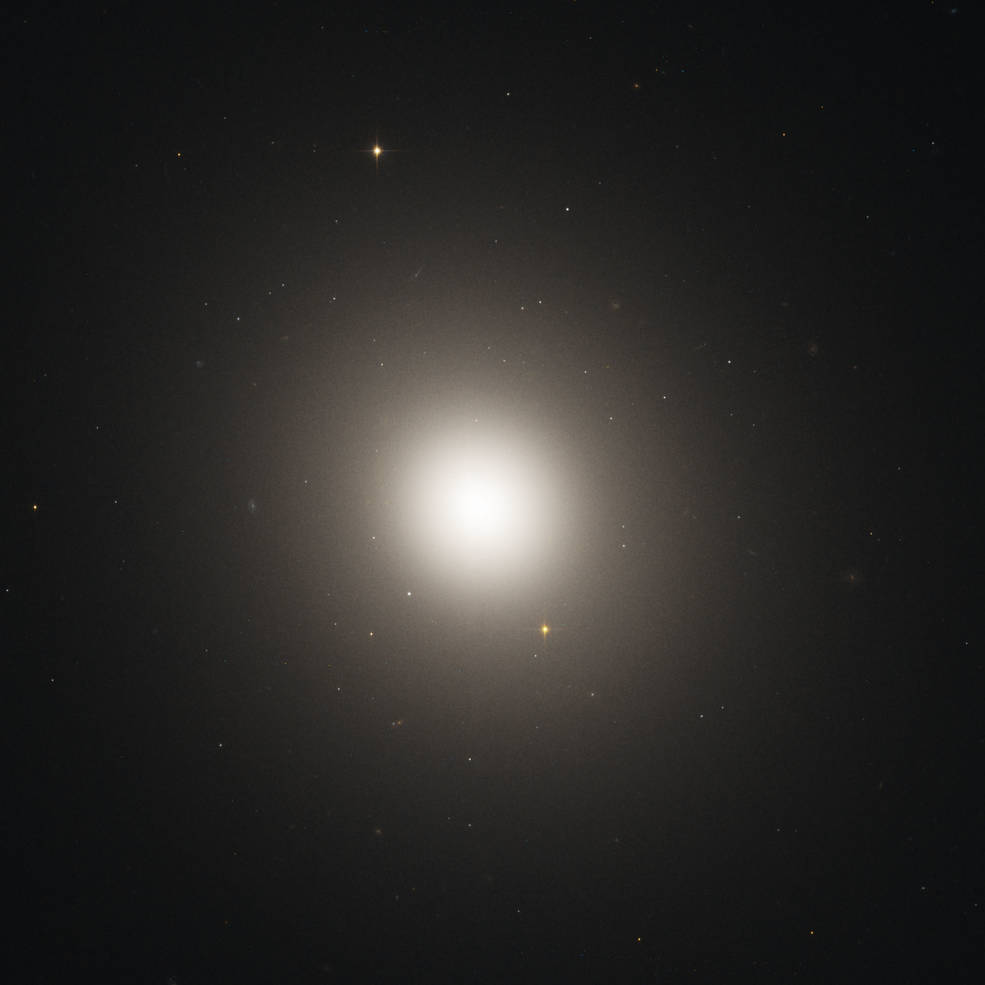
- Messier 105 (an elliptical galaxy) also discovered by Pierre Mechain, a French Astronomer, in 1781
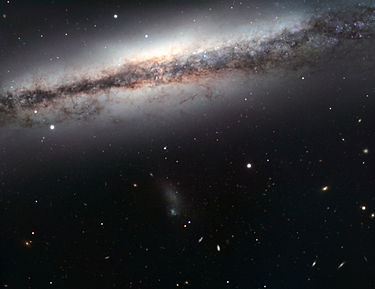
- NGC 3628 (an unbarred spiral galaxy) discovered by William Herschel in 1784
The Leo Triplet is a group of 3 galaxies found within the Constellation Leo, and is also referred to as the M66 Group.
There are 3 interacting spiral galaxies within The Leo Triplet – M65 (Messier 65), M66 (Messier 66) and NGC 3628.
The Leo Triplet is also known as the Hamburger Galaxy and is located approximately 35 million light years from Earth.
The Leo Ring is a massive intergalactic cloud that consists of hydrogen and helium gas. It is located in orbit of two galaxies in the center of the Leo group of galaxies within the Constellation of Leo.
Although The Leo Ring cloud was only discovered as late as 1983, it is believed that over a billion years ago two galaxies may have collided at the center of the Leo Group.
Those two galaxies were Messier 96 and NGC 3384 and gas was expelled into intergalactic Space, forming a huge set of clouds known as the Leo Ring
What is the Milky Way?
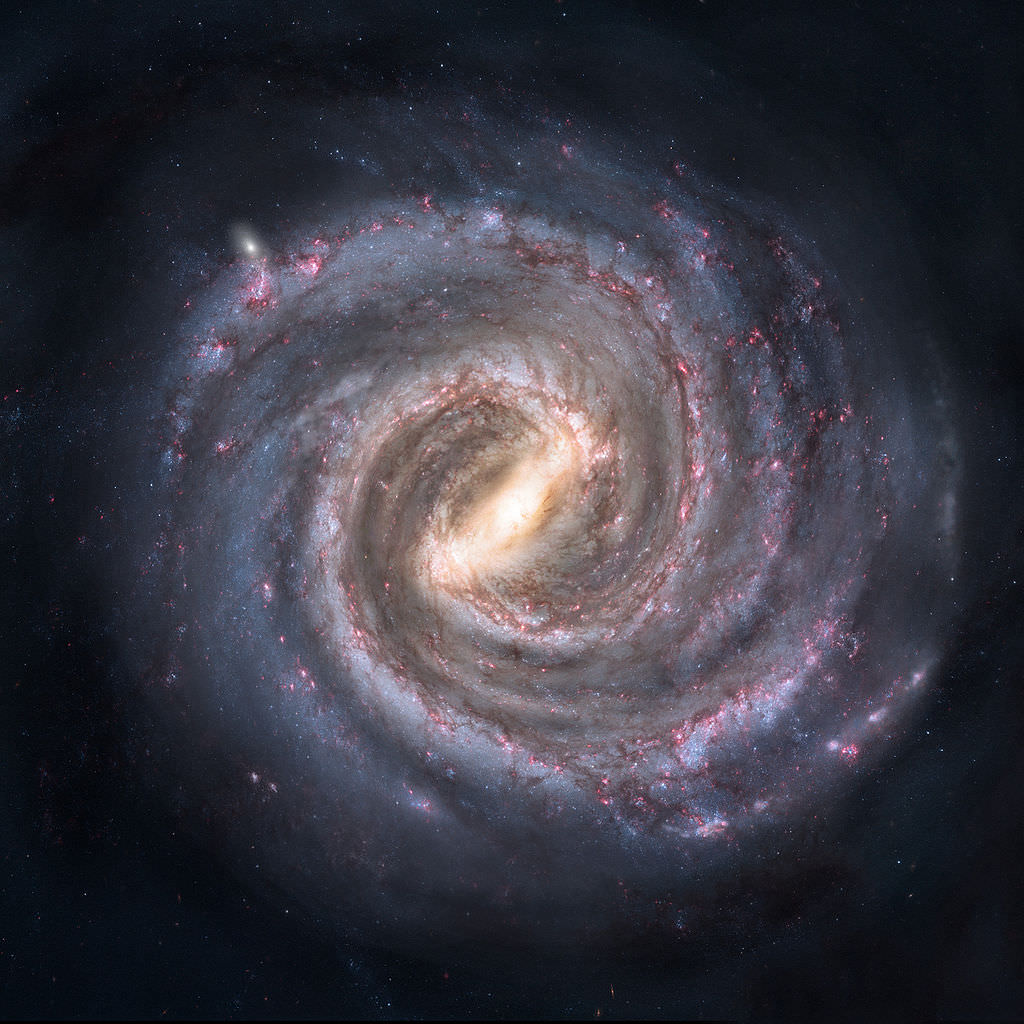
The Milky Way is a Spiral Galaxy, containing over 200 billion Stars, and forms part of the Constellation of Sagittarius. The Milky Way itself is not a Constellation of Stars.
This is the Galaxy that contains our solar system and it gets its name from the fact that it looks like a hazy swirl or river of milk across the sky, when viewed from earth.
It is made up of Gas, Dust and Stars, with spiral arms wrapped around it, and a massive black hole in the center of the Galaxy. Not all of the Stars in the Universe are contained within the Milky Way.
It is at its brightest if looking towards the galactic center in the direction of Sagittarius.
The Stars that make up the Milky Way cannot be individually identified by the naked eye.
Historical significance: the legends, and myths surrounding Constellation Leo
Myths
There are many Greek and Roman myths and legends surrounding the origin and names of the constellations, from Hercules, or Heracles killing the Lion to protect the women it had kidnapped .
When it comes to the many recognized constellations in the sky, Constellation Leo is one of the oldest.
Archaeological records show that around 4000 BC, The Mesopotamian civilization (the first known civilization) identified a constellation like Leo.
FACT: The ancient lands of the Mesopotamians now stretches across Turkey, Syria, Iraq and Kuwait
For thousands of years, various cultures around the world have identified and named the constellation we know and see in the night sky as Leo, or a name relating to the Lion, or the Nemean Lion from Nemea, in Corinth.
Other names in different countries for Leo include:
- Iran, the Persian people named it – Ser or Shir
- Syria, the Syrians named it – Tyro
- Turkey, the Turks named it – Aryan
- Israel, the Jewish people named it – Lyre
- India, the Indian people named it – Simha
- SE Mesopotamia, (modern day Iraq) the Babylonians named it – UR.GU.LA or the Great lion.
The Babylonians also recorded details of Regulus, the bright star within Leo, as The Great Lion constellation.
They regarded Regulus as – the star that stands at the Lion’s breast – or sometimes The King Star.
Greek mythology
In Greek mythology, The Greeks associated Constellation Leo with the Nemean Lion.
The Nemean Lion was the beast that was killed by Heracles in the first of his twelve labors. The Lion had tough skin and was very difficult to kill but eventually Heracles succeeded and removed the skin and head and wore it as a protective suit.
As the Nemean Lion was believed to be brave it is said that the Greek God Zeus then placed an image of the Lion up with the other constellations in a prime position, it to remind us that it is the King of the beasts.
What is the ‘Big Dipper”?
When we take an interest in the different objects in the night sky one of the first patterns we learn to recognize is the ‘Big Dipper’.
The Big Dipper is not a constellation it is an asterism.
In fact, The Big Dipper is the best-known asterism and one of the most easily recognized patterns in the northern sky at night. It is within the Constellation Ursa Major (the Great Bear).
The Big Dipper is known by different names across the world but it is the same arrangement of stars forming the pattern. It is also known as:
- The Plough, the Saucepan, and the Great Wagon
What is the difference between a constellation and an asterism?
An asterism is a group of stars that appear to form a pattern in the night sky but with no officially determined boundaries.
It can make up part of a constellation or cross the boundaries of an official constellation or even a defunct constellation.
An asterism is a more vague assembly of stars than a recognized constellation.
Characteristics of a Leo
The constellation of Leo is one of the 12 constellations of the Zodiac and as such is represented by the birth star sign of Leo.
We know what Leo looks like in the night sky in the Northern Hemisphere but what are the typical personal characteristics of someone born under the zodiac sign of Leo like?
The Star sign of Leo includes people born between, July 23 to August 23. Its Sanskrit name is Simha (meaning the Lion).
The typical characteristics of a Leo, is related to having a fiery nature and a natural leader in the Zodiac, as symbolized by a Lion.
Other characteristics, also represented by the ancient Greek, Roman and Mesopotamian cultures, are ruler-ship and natural born leadership, Kings and Royalty, strength and possessing a determination to succeed or dominate.
As a fire element they can also be warm-hearted.
It’s Make up – Leo is one of the easiest Constellations to spot in the night sky because of its distinctive outline of a Lion and this image is widely used for many products and commercial objects as an easy to recognise image.
The meteor showers
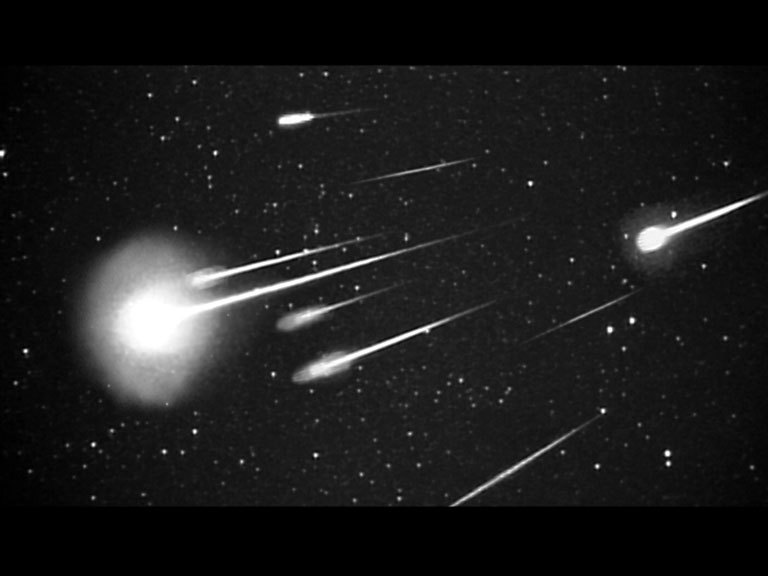
The Leo Constellation is associated with 2 meteor showers known as the Leonids.
The Leonids meteor shower is around November 17-18, in the Northern Hemisphere, and has a radiant near the bright star – Gamma Leonis.
The other Leonids meteor shower occurs around January 1-7.
Fun Facts about Leo – Did you know that?
- In the Harry Potter series some characters were named after stars in the solar system and other celestial objects – Harry Potter’s Grandfather was called Sirius and his brother was named Regulus Black after the brightest Star in Leo called Regulus.
- Constellations are not part of the solar system; they are groups of stars that appear to form shapes that are visible from Earth.
- The largest Constellation is called Hydra and the smallest Constellation is called Crux.
- The Sun does not belong to any constellation.
- The Big Dipper is known as The Plow (The Plough in the United Kingdom), it is mistaken for a constellation in the night sky but in fact it is an asterism.
- A Constellation does not actually exist as a fixed object, it is a group of bright stars that happen to be in a random place and are light years apart and ever moving. We see the pattern of their presence.
- Algieba (Gamma Leonis) is a double star in Leo and can be easily seen with a small telescope even though it is a distance of 130 light years from the Sun. It has appears to have red orange and greenish yellow hues of color.
- Leo, the Latin name, for this Constellation has been recognized as the shape of a lion by many ancient cultures including the Persians, the Mesopotamians, the Greeks, the Babylonians, the Syrians and the Turks.
- The Star Zosma is hotter and larger than the Sun.
- Constellations are not found in the Solar System. There are various objects within our Solar System from Planets to new planetary-mass objects that have been classified as Dwarf Planets. Pluto has now been downgraded to Dwarf Planet status joining the 4 other Dwarf Planets.
Commonly Asked Questions
Q. What is the celestial sphere?
A. In astronomy and navigation terms, the celestial sphere is imaginary.
This virtual sphere has a large radius that is concentric with Earth.
We can imagine all objects in the night sky as being projected upon the inside of this celestial sphere, as if it was images placed inside a dome.
Q. What prevents us seeing the Stars and Constellations in the night sky?
A. Light pollution, fog, city lights and artificial lights all limit our visibility of the objects in the sky at night.
The best views come from outside of cities where light pollution is less. Camping in the countryside is one of the best ways to get a better view of what’s up there in Space.
Q. Will the Constellations change over time?
A.The Constellations are continually on the move.
The images we form in our imagination to make objects, shapes and patterns out of the constellations have already shifted over time. As we view the night skies from Earth they are likely to continue to do so and possibly in time the images may look very different.
SOURCES:
- https://star-name-registry.com/leo
- https://holy-world-war-fan-fiction-series.fandom.com/wiki/Nemean_Lion
- https://earthsky.org/constellations/leo-heres-your-constellation
- http://www.hellenicaworld.com/Greece/Science/en/PtolemyAstronomy.html
- https://apod.nasa.gov/apod/ap070601.html
- https://en.wikipedia.org/wiki/Messier_95
- https://www.nasa.gov/feature/goddard/2017/messier-96
- https://www.nasa.gov/feature/goddard/2017/messier-105
- https://en.wikipedia.org/wiki/NGC_3628
- https://sedsvit.medium.com/just-us-d4ab577099a2
- https://solarsystem.nasa.gov/asteroids-comets-and-meteors/meteors-and-meteorites/leonids/in-depth